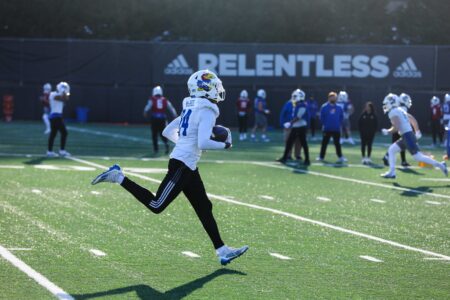Snapper helps shore up KU punting

Kansas long snapper Tanner Gibas, far right (59), laughs with teammate Justin Carnes (54) and punter Victor McBride prior to kickoff against Northern Illinois in this file photo from Sept. 10, 2011.
Although it has gone largely unnoticed, one of the biggest areas of improvement for Kansas University’s football team thus far has come in the kicking game.
Specifically, on punts.
True freshman Tanner Gibas substantially has upgraded the Jayhawks’ long snapping and, as a result, first-year punter Ron Doherty has had a much easier time getting off kicks than his predecessor did a season ago.
In Kansas’ first three games, Doherty has bombed 10 punts for a 47.8-yard average. The average places Doherty 12th in the nation, and his numbers include a long of 56 yards, one downed inside the 20 and one touchback. The most impressive number, though? Zero blocked.
That’s where Gibas, 6-foot-2, 200 pounds, enters the picture. Because he’s spent the last three years of his football life focusing on nothing but snapping, Gibas stepped onto KU’s campus ready to make an impact.
“When I got recruited, coach told me there was an opportunity for me to come in and play right away,” he said. “They just kept telling me they were looking for a snapper.”
The Jayhawks found one who has the skill in his blood.
“I picked it up from my brother,” said Tanner of his older brother Corey, a four-year starter at Texas A&M. “He did it ever since he was little and was always good at it. One of my teachers in school was (former UCLA long snapper) Chris Rubio. He told my dad that my brother could get a scholarship for this. He didn’t believe him. Dad always said, ‘My son’s gonna be a safety,’ but he ended up working with my brother and he got really good.”
Tanner also got involved, picking up the craft during his sophomore year at Charter Oak High in Covina, Calif.
“I was actually real surprised,” Corey said. “He wasn’t really big into football in middle school. But when he told me he was going to play, that’s how we actually got closer. During the middle of his sophomore year, he started seeing Chris Rubio, and from there on he just got better and better.”
Both Corey and Tanner compared the art of snapping to a golf swing. It’s full of precise movements, and the goal is to make it the same every time. Although Tanner could not pinpoint what makes a perfect snap, he was quick to point out what makes a bad one.
“If you grip the ball too tight, the ball might come out wobbly,” he said. “If you don’t follow through with both hands evenly, the ball can sail different places. If you don’t lock out legs or you don’t lean back or bring your eyes through … there’s a lot of things that go into snapping. You mess up one little thing it can totally jack up the snap.”
During his career at A&M, Corey said he delivered just two bad snaps. So far at Kansas, Tanner is 10-for-10 on good snaps.
“He used to always tell me he would record my games and watch my form and try to copy me and critique it in his own way,” Corey said. “That’s helped him out a lot. I’m excited for him, and I think he’s gonna be better than me.”
As for any tips on how to get to that point, Corey kept that in the family, as well.
“The only advice I really gave him is just what my dad always told me, ‘Don’t think, trust your body and let it fly,'” he said.
Corey, who still lives in College Station, Texas, said he’ll be at Kyle Field in late November, when Tanner’s Jayhawks take on Texas A&M. As for which team he’ll be rooting for, deciding that is almost as difficult as perfecting a snap.
“Because of Tanner, Kansas is my second-favorite team,” Corey said. “I told him I’d wear blue boxers for him when I come watch. I’ll be sitting in KU’s section, and I might wear something else red and blue, but I’ll probably have to keep an A&M hat on, too.”







